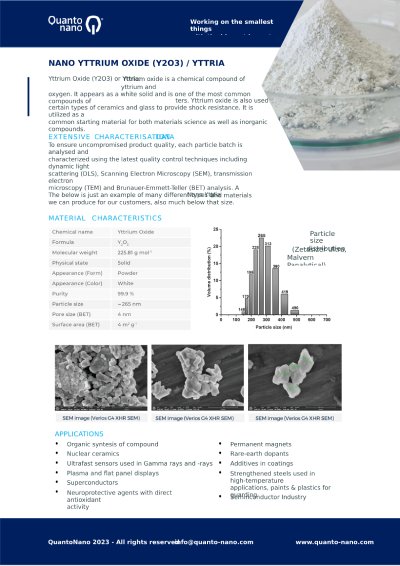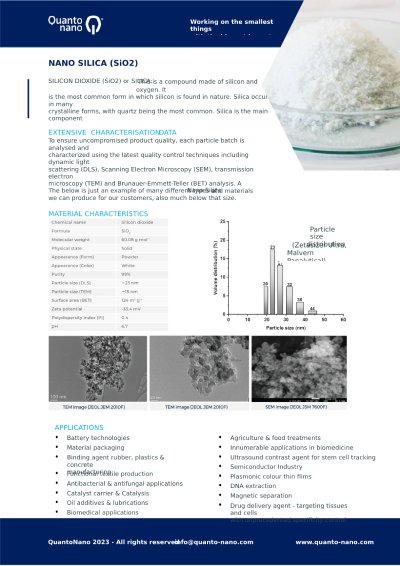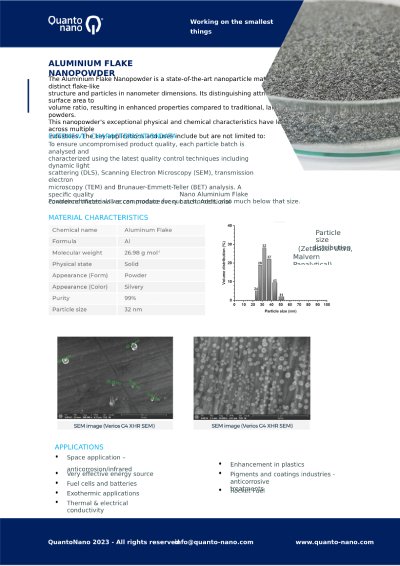Nano Materials
Additives
Quanto Nano
Product Categories
Quanto Nano
Commonly used additives for metal alloy’s and special metals production:
These are like microscopic, super-strong straws made of carbon. They're incredibly strong and conductive. When added to metals, they can drastically increase strength, conductivity, and even thermal properties. They're a popular choice for advanced applications like aerospace materials.
Send Inquiry
Think of nano-silica as tiny, ultra-fine sand particles. They're often used to improve wear resistance and mechanical strength. Nano-silica can be especially useful in aluminum alloys, enhancing their performance without significantly increasing weight.
Send Inquiry
These are like tiny, powerful particles that can improve corrosion resistance, which is super important for metals exposed to harsh environments. They're often used in steel alloys.
Send Inquiry
Imagine tiny particles of aluminum oxide. These are used to increase hardness and wear resistance in metal alloys. They're particularly useful in cutting tools where hardness is key.
Send Inquiry
These are like minuscule silver bits known for their antimicrobial properties. When added to metal alloys, they can impart antibacterial properties, which is fantastic for medical equipment or any application where hygiene is critical.
Send Inquiry
This is essentially a one-atom-thick layer of graphite. It's incredibly strong and conductive. When added to metals, graphene can significantly improve tensile strength, electrical and thermal conductivity, and even reduce weight. It's a game-changer for lightweight, high-performance applications.
Send Inquiry
Like carbon nanotubes but made with boron and nitrogen, these tubes are excellent at improving thermal properties. They're particularly useful in high-temperature applications.
Send Inquiry
These tiny particles are great for improving UV resistance and anti-corrosive properties. They're often used in coatings for metal surfaces exposed to sunlight and harsh weather.
Send Inquiry
Quanto Nano
Nano Additives For Oil Improvements:
These typically include nanoparticles like carbon black or silica. They work to improve the dispersion of particles in oil, preventing sludge and varnish formation.
Send Inquiry
Common materials include zinc oxide (ZnO) and titanium dioxide (TiO2) nanoparticles. These form a protective layer on metal surfaces to reduce friction and wear.
Send Inquiry
Molybdenum disulfide (MoS2) and tungsten disulfide (WS2) nanoparticles are popular choices. They significantly reduce friction between moving parts due to their unique layered structures.
Send Inquiry
Cerium oxide (CeO2) nanoparticles are a common choice, known for their ability to protect metal surfaces from corrosion.
Send Inquiry
Nanoscale forms of traditional antioxidants, like zinc dialkyl dithiophosphate (ZDDP), are used. Their small size allows for a more uniform distribution in the oil, enhancing oxidative stability.
Send Inquiry
Magnesium and calcium sulfonate nanoparticles are often used. They help neutralize acids and clean deposits from metal surfaces, keeping engine parts clean.
Send Inquiry
Iron oxide (Fe2O3) nanoparticles are commonly used for their rust-preventing properties, especially in storage and off-season protection.
Send Inquiry
Polymethyl methacrylate (PMMA) and polyisobutylene (PIB) nanoparticles are used to maintain oil viscosity over a wide temperature range.
Send Inquiry
Polymers like polyalkyl methacrylates in nano form are used to lower the pour point of oil, ensuring fluidity in cold conditions.
Send Inquiry
Silicon dioxide (SiO2) nanoparticles are effective in reducing the formation of foam in the oil, which can otherwise decrease lubrication efficiency and increase oxidation rates.
Send Inquiry











